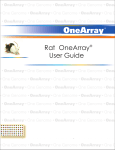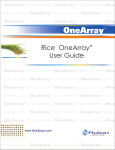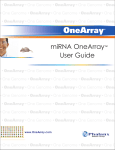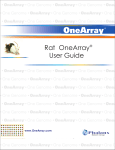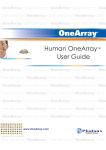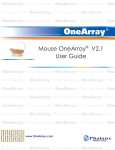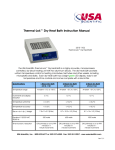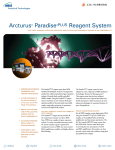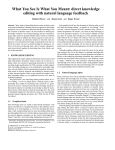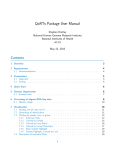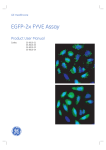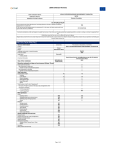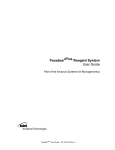Download Human v4 and Mouse v1 - Phalanx Biotech Group
Transcript
Human & Mouse DNA Microarray User Guide www.OneArray.com Notice to the User IMPORTANT! It is important that users read the entire manual before commencing work. Phalanx Biotech Group OneArray User Manual v3.3 i Warranty and Liability Phalanx Biotech Group’s products are intended for research use only, and not intended for any other uses. OneArray™ microarray products are designed and manufactured for research use only. Buyers and users agree and understand that they are not granted the right to use OneArray products for clinical diagnostic purposes unless they obtain written approval from the appropriate government authority. Phalanx Biotech Group (Phalanx Biotech) will not be liable for any damages arising from the use of its products in any manner other than their intended use or for the use of its products for clinical diagnostic purposes without written approval from the appropriate government authority. The manufacture, sale, or importation of products from Phalanx Biotech is not permitted without the prior written consent from Phalanx Biotech. Buyers and users agree and acknowledge that Phalanx Biotech is the owner and has the copyrights to the probe sequence information of the Mouse OneArray™ product, Human OneArray™ product, and any other OneArray products. Phalanx Biotech is founded on the mission to offer researchers high-quality and user-friendly solutions at an affordable price. Your satisfaction in using our products is very important to us. Therefore, if any of our products is not performing to the standard we promised, we are willing to replace the product, or credit the product purchase price. Phalanx Biotech accepts liability of ONLY the purchase price of its products, and has no other liabilities. ii OneArray User Manual v3.3 Phalanx Biotech Group Contact Information U.S. Office Phalanx Biotech Group 1400 Page Mill Road, Bldg. B Palo Alto, CA 94304-1124 Ph: 650.320.8669 FAX: 650.320.8488 E-mail: [email protected] Web site: www.phalanxbiotech.com www.onearray.com Asia Office Phalanx Biotech Group 6 Technology Road 5, 6th Floor Hsinchu Science Park Hsinchu 30077, Taiwan Ph: 886.3. 5781168 FAX: 886.3. 5785099 E-mail: [email protected] Web site: www.phalanxbiotech.com Phalanx Biotech Group OneArray User Manual v3.3 iii User Guide and Technical Support Electronic version of this manual is available on the enclosed Product Support CD, and online at: www.phalanxbiotech.com To reach technical support by telephone, call Within the US: 1.650.320.8669 Outside the US: 886.3. 5781168 Feedback We welcome your feedback regarding our products and this manual. Please contact us at: [email protected] All comments are welcome. iv OneArray User Manual v3.3 Phalanx Biotech Group Trademarks and Copyrights Mouse OneArray™ , Human OneArray™, and OneArray™ are trademarks of Phalanx Biotech Group, Inc. in the United States and in other countries. All trademarks and copyrights used in this manual belong to their respective owners and are the sole property of their respective owners. CyDye™ and Cy™ are trademarks of GE Healthcare. AlphaScan™ is a trademark of Alpha Innotech, Inc. ArrayWoRx® Biochip Reader is a registered trademark of Applied Precision®, Inc. GenePix™ is a trademark of Molecular Devices. GeneTAC™ is a trademark of Genomic Solutions®, Inc. ScanArray™ 5000 is a trademark of Perkin Elmer®, Inc. mSerries LifterSlip™ 25x601M-5439 is a trademark of Erie Scientific Company®. Amino Allyl MessageAmp™ II aRNA is a trademark of Ambion®. ArrayControl™ is a trademark of Ambion®, Inc. Amino Allyel cDNA Labeling Kit is a trademark of Ambion®. Superscript Indirect Labeling System is a trademark of Invitrogen, Fairplay II Microarray Labeling Kit is a trademark of Strategene. Mini-Elute PCR purification is a trademark of Qiagen®. SpotReport is a registered trademark of Strategene, Inc. Last updated July 2008 © 2005 - 2008 Phalanx Biotech Group. All rights reserved. Phalanx Biotech Group OneArray User Manual v3.3 v Thank You Phalanx Biotech Group would like to extend special thanks to our customers who have provided feedback that enabled us to improve the OneArray User Guide. vi OneArray User Manual v3.3 Phalanx Biotech Group Table of Contents Getting Started ........................................................................1 Product Contents-------------------------------------------------------------------------- 1 Other Necessary Apparatus and Reagents (Not Supplied) ----------------------- 2 Important Notes on Microarray Handling and Storage--------------------------- 4 Product Descriptions and Overview--------------------------------------------------- 5 Using OneArray ........................................................................9 Step 1: Prepare the RNA Sample--------------------------------------------------- 10 Step 2 Label the Target-------------------------------------------------------------- 11 Step 3: Pre-Hybridize the Microarray -------------------------------------------- 14 Step 4 Complete the Hybridization Protocol ------------------------------------ 15 Step 5: Wash the Hybridized Microarray ---------------------------------------- 21 Step 6 Scan and Extract Gene Expression Results----------------------------- 22 Step 7 Check the Control Probe Data -------------------------------------------- 25 Phalanx Biotech Group OneArray User Manual v3.3 vii Getting Started Getting Started Please read the introductory information below to help familiarize yourself with OneArray™ before use. Product Contents ¾ Human or Mouse OneArray™ DNA Microarray ¾ OneArray™ Hybridization Buffer Tube • Each tube contains buffers sufficient for 5 to 10 microarray hybridization procedures ¾ Spare round cap tube ¾ OneArray™ User Guide ¾ Spotted Region Guide ¾ Product Support CD, which contains the following: • Sample Images • OneArray .gal file • OneArray gene list and probe sequences • OneArray microarray layout • OneArray Control Probe list • OneArray User Guide (electronic version) • SimpleMeasure experimental control analysis program Phalanx Biotech Group OneArray User Manual v3.3 1 Getting Started Other Necessary Apparatus (Not Supplied) Apparatus ¾ ¾ ¾ ¾ ¾ ¾ ¾ ¾ ¾ ¾ ¾ ¾ ¾ ¾ ¾ ¾ 2 Water bath/heating block Powder-free gloves Clean, blunt forceps Micropipettors Sterilized and nuclease-free pipet tips Sterilized and nuclease-free microcentrifuge tubes High-speed microcentrifuge Low-speed tabletop microcentrifuge with slide holder attachment Vortex mixer Hybridization oven Hybridization accessories: chamber cover slides, etc. Rectangular slide staining dish and slide rack for washing microarrays PCR (polymerase chain reaction) machine Microarray scanner for standard 1” x 3” format (see Table 8 under “OneArray Microarray Scanner Specifications” for a list of compatible scanners) Hybridization systems (optional) Automated hybridization station (optional) OneArray User Manual v3.3 Phalanx Biotech Group Getting Started Other Necessary Reagents (Not Supplied) Reagents ¾ De-ionized nuclease-free water ¾ Cyanine 3- or 5-labeled amplified aRNA sample, or Cyanine 3- or 5-labeled cDNA sample ¾ 20X SSPE stock solution, sterile filtered: o 3.6 M Sodium chloride o 0.2M Sodium phosphate (pH 7.7) o 20mM EDTA ¾ Wash Solutions, sterile filtered (four types, approximately 250 mL of each is required per experiment): o 2X SSPE, 0.1% SDS o 2X SSPE o 0.1X SSPE, 0.1% SDS o 0.1X SSPE o NOTE: SDS must be molecular biology grade. ¾ Pre-hybridization Buffer, prepared and sterile filtered immediately prior to pre-hybridization: o 5X SSPE, 0.1% SDS, 1% BSA o NOTE: BSA must be molecular biology grade. ¾ Deionized formamide to be added to the OneArray Hybridization Buffer prior to use (see Step 4A). ¾ RNA Fragmentation Reagent and Stop Solution (for hybridization using aRNA) ¾ DNA Blocking Mixture: o Ambion® sheared Salmon Sperm DNA (10 μg/μl), or o Invitrogen™ Cot-1 DNA® (2.5 10 μg/μl), or o Invitrogen™ Poly-A (2.5 10 μg/μl) Phalanx Biotech Group OneArray User Manual v3.3 3 Getting Started Important Notes on Microarray Handling and Storage Storage Conditions ¾ Store unopened OneArray product at room temperature. ¾ Store opened OneArray product at 4°C. ¾ Store OneArray Hybridization Buffer at room temperature. NOTE: If the product is received with an open bag, please contact Phalanx Biotech Customer Service for an immediate replacement. Handling Microarrays IMPORTANT! Please read this section carefully and follow the instructions! ¾ Polynucleotide probes are printed on the side of the slide with the barcode. ¾ To avoid irreparable damage of the printing area, do not touch the surface with bare hands, or with any other objects. ¾ Whenever possible, handle microarrays with clean blunt forceps to avoid contamination. IMPORTANT! 4 Open arrays should be used within a week. OneArray User Manual v3.3 Phalanx Biotech Group Getting Started Product Descriptions and Overview OneArray™ Whole Genome DNA microarrays are made of sense-strand polynucleotide probes spotted onto a proprietary chemical layer coated on top of a 1” x 3” (25 mm x 75 mm) standard-format microarray glass slide. Updated information of genome content from public domains is used to design approximately 30,000 highly sensitive long-oligonucleotide probes for monitoring the expression level of corresponding protein-coding genes. Each probe is spotted onto the array in a highly consistent manner using a proprietary, non-contact spotting technology adapted for microarray manufacturing. Mouse OneArray Genome Content Each microarray contains 31,802 oligonucleotides: 29,922 mouse genome probes, and 1880 experimental control probes. Mouse OneArray content is based on an abridged version of the Mouse Exonic Evidence Based Oligonucleotide (MEEBO)*. MEEBO is a new set of 70-mer probes specifically for DNA microarrays that was created by a team of researchers from the University of California, San Francisco and elsewhere, and was headed by Dr. Ahs Alizadah. MEEBO has been made available to the public. For more information about MEEBO, access the following Web sites: http://arrays.ucsf.edu/archive/meebo.html http://genome-www5.stanford.edu * Special thanks to Dr. John Coller for his helpful discussion in the selection of probe sets for reduction. Phalanx Biotech Group OneArray User Manual v3.3 5 Getting Started Table 1, below, provides an example of the contents of a mouse genome that can be studied using the Mouse OneArray. Table 1: Mouse Genome Content Probe Type Number of Probes MEEBO (abridged version) 29,922 (total)* Group Code: MC Mouse constitutive exonic: Rockefeller MouSDB3 Constitutive exons and locuslink2ucsf constitutive exons 24,858 Group Code: MR Mouse mRNAs; mRNA derived 70-mer probes, which may span >1 exon 5,064 * Mouse OneArray is guaranteed to contain > 98% of the total probe content. Mouse OneArray Control Features There are 1,880 control probes built into the Mouse OneArray DNA microarray that monitor the sample quality and hybridization process. These control probes provide valuable information to ensure experiments are done correctly to ensure higher quality results for analysis. SimpleMeasure™ is a small, free Java-based applet designed to analyze control probe data and generate easy-to-interpret graphs. The program can be downloaded from http://www.phalanxbiotech.com/Support/Downloads.html NOTE: Detailed control information, gene lists, gene annotations, and probe sequences can be found on the Product Support CD that accompanied this product, or at: http://www.phalanxbiotech.com 6 OneArray User Manual v3.3 Phalanx Biotech Group Getting Started Human OneArray Genome Content Each microarray contains 32,050 oligonucleotides: 30,968 human genome probes, and 1082 experimental control probes. Each oligonucleotide probe is designed to hybridize to a specific target gene described in the current public domain contents, such as UniGene, Cancer Genome Anatomy Project (CGAP), BioCarta, Kyoto Encyclopedia of Genes and Genomes (KEGG), and validated by the Human Genome Sequencing Project (HGSP). Table 2, below, provides an example of the contents of a human genome that can be studied using the Human OneArray. Table 2: Human Genome Content Probe Type Number of Probes UniGene and RefSeq based 30,968 (total)* UniGene build #175 based and/or RefSeq based with Entrez Gene ID including: CGAP (Cancer Genome Anatomy Project) BioCarts and KEGG (Kyoto Encyclopedia of Genes and Genomes) pathways 28,703 UniGene build #163 based with Gene ID and experimentally selected 2265 * Human OneArray is guaranteed to contain > 98% of the total probe content. . Phalanx Biotech Group OneArray User Manual v3.3 7 Getting Started Human OneArray Control Features There are 1,082 control probes built into the Human OneArray DNA microarray that monitor the sample quality and hybridization process. These control probes provide valuable information to ensure experiments are done correctly resulting in higher quality results for analysis. SimpleMeasure™ is a small, free Java-based applet designed to analyze control probe data and generate easy-to-interpret graphs. The program can be downloaded from http://www.phalanxbiotech.com/Support/Downloads.html NOTE: Detailed control information, gene lists, gene annotations, and probe sequences can be found on the Product Support CD that accompanied this product, or at: http://www.phalanxbiotech.com 8 OneArray User Manual v3.3 Phalanx Biotech Group Using OneArray Using OneArray This section provides you with detailed information about how to perform the steps necessary to complete the hybridization process to study gene expressions using the OneArray microarray. IMPORTANT! Follow these detailed steps exactly to achieve the best experimentation results. ¾ ¾ ¾ ¾ ¾ ¾ ¾ Step 1: Prepare the RNA Sample Step 2: Label the Target Step 3: Pre-Hybridize the Microarray Step 4: Perform the Hybridization Protocol Step 5: Wash the Hybridized Microarray Step 6: Scan and Extract Gene Expression Results Step 7: Check Control Probe Data Phalanx Biotech Group OneArray User Manual v3.3 9 Using OneArray Step Step 1: 1: IMPORTANT! Prepare the RNA Sample High-quality, intact RNA is essential for all gene expression microarray experiments. There are many different RNA isolation protocols and commercially available RNA isolation kits. You should choose a solution that meets your specific needs. Stratagene, Ambion, Invitrogen and other reagent companies offer many different RNA isolation products. For more information, you can visit each company’s Web site. Once the RNA samples are isolated, you must confirm the quantity and quality of the samples. Similarly, many different protocols are available and you should choose a solution that is suitable for your needs. For faster and more automated RNA analysis, you may want to consider the “No Cuvettes” Spectrophotometer from NanoDrop®, or the 2100 Bioanalyzer from Agilent Technologies. For more information, visit each company’s Web site. 10 OneArray User Manual v3.3 Phalanx Biotech Group Using OneArray Step 2 Step 2: IMPORTANT! Label the Target For best results, it is recommended that you use one of the commercially available labeling kits that has been tested for use with the OneArray microarray—please refer to Tables 3 and 4 below. General Guidelines for Target Labeling There are many commercially available labeling kits for microarray analysis. Select a labeling kit or labeling method that is most suitable for your specific needs. If you use a labeling kit that is not listed in Tables 3 nor 4, it is recommended that you validate the method to test and determine its compatibility with the OneArray. You may want to confirm the quality of the labeled target with the “No Cuvettes” Spectrophotometer from NanoDrop®. RNA Sample Amounts Generally, the amount needed of quality RNA is 10-20 μg for each labeling reaction. If you have an ample supply of RNA samples, you have the choice of using a protocol that either amplifies or does not amplify the RNA sample. If you have a limited amount of RNA samples, it is recommended that you use a protocol that includes a linear amplification of the RNA samples. Dye Incorporation Efficiency Good dye incorporation rates are important for yielding the best data from microarray hybridization. Incorporation rates of 30-60 dye molecules per 1000 bases (17-33 bases/dye molecule) yield the most usable data. Rates below 20 dyes per 1000 bases (50 bases/dye) are very low and may lead to a loss of signal of many Phalanx Biotech Group OneArray User Manual v3.3 11 Using OneArray targets. It is not recommended to perform hybridization with samples of low dye incorporation efficiency. For aRNA Hybridization Follow the instructions provided by the reagent supplier. Indirect labeling with NHS ester dye is recommended. Table 3, below, contains a list of products that have been tested for use with OneArray. Table 3: aRNA Preparation Products Manufacturer Product Name and Description Ambion® Amino Allyl MessageAmp II™ aRNA Kit Ambion® aRNA Fragmentation Reagent Epicentre® Biotechnologies TargetAmp™ 1-Round AminoallylaRNA Amplification Kit For aRNA labeling, >10 μg of quality aRNA is recommended. Smaller volumes can lead to significant loss of sample and may increase the concentration of contaminants in the labeled aRNA sample, leading to higher background signal. It is best to use aRNA as soon as possible after labeling, as exposure to air and light can reduce the signal of some dyes. If it must be left overnight, it is best to aliquot your labeled aRNA and store in the dark at -80°C. Avoid thawing and refreezing aRNA if possible, as freeze-thaw cycles can damage the aRNA. Finally, aRNA fragmentation is best performed immediately prior to hybridization (Step 4B). 12 OneArray User Manual v3.3 Phalanx Biotech Group Using OneArray For cDNA Hybridization Follow the instructions provided by the reagent supplier. Indirect labeling with NHS ester dye is recommended. Table 4, below, contains a list of products that have been tested for use with OneArray. Table 4: cDNA Preparation Products Manufacturer Product Name and Description Ambion® Amino Allyl MessageAmp II™ cDNA Kit Invitrogen™ Superscript Indirect Labeling System Stratagene® Fairplay II Microarray Labeling Kit For cDNA labeling, it is recommended that 15 μg of total nucleic acid be used as starting material. For all cDNA preparation, it is strongly recommended that you re-purify the targets using the Qiagen® Mini-Elute PCR purification column prior to hybridization according to the manufacturer’s protocol. Incomplete removal of unincorporated dye from the labeling reaction often contributes to increased background noise. The Qiagen Mini Elute PCR has been found to consistently provide more reliable results. Phalanx Biotech Group OneArray User Manual v3.3 13 Using OneArray Step 3: Step 3: Pre-Hybridize the Microarray General Instructions IMPORTANT! OneArray requires a pre-hybridization step prior to hybridization of the labeled target. The pre-hybridization step reduces background signals and increases the performance of the microarray. Complete the prehybridization step by carefully following the instructions below. 1) Warm the pre-hybridization solution (5X SSPE, 0.1% SDS, and 1% BSA) to 42{C. 2) Pour 25 ml room temperature 100% ethanol into the spare array tube. 3) Preheat the OneArray(s) in the round cap tube at 60{C for 10 min (hybridization oven recommended). 4) Remove the OneArray(s) from the round cap tube, place in the two outermost slots inside the tube containing 100% ethanol, close the cap, and let sit for approximately 15 sec. 5) Shake the round cap tube for 20 sec. 6) Remove and thoroughly rinse each array with deionized water to remove any residual ethanol. 7) Carefully and slowly, fully submerge the OneArray in an abundant amount of pre-hybridization solution for 2 hr at 42{C (35 ml is sufficient if using a round cap tube). IMPORTANT! 14 Try to insert the slides into the correct position the first time. Avoid inserting and removing the slides more than once in the pre-hybridization buffer. OneArray User Manual v3.3 Phalanx Biotech Group Using OneArray 8) After 2 hr, transfer the slide(s) to room temperature, distilled water and wash gently for 2 min. 9) Spin dry the slide(s) for 2 min. Store in a dry, dark place until hybridization. It is recommended that you use the slides in the hybridization protocol within 1 hr of completing the pre-hybridization process. Step 4: Complete the Hybridization Protocol Once you have completed the pre-hybridization step using one of the methods outlined in the Step 3: Pre-Hybridize the Microarray section, you are ready to complete the hybridization protocol. There are many different hybridization protocols, apparatus, and instruments available that may be compatible for use with the OneArray microarray. Detailed instructions for using the glass cover slide method are described below. For best performance and consistent hybridization results, it is recommended that you use the OneArray Hybridization Buffer™, included with this product to complete the hybridization process. Step 4A:ÎPrepare Hybridization Solution Using the OneArray Hybridization Buffer (Included) IMPORTANT! For correct use of this buffer, you must add a specific amount of formamide and labeled target. Please follow the instructions below carefully. 1) Spin down the stock OneArray Hybridization Buffer (~410 μl in each tube). 2) Add 90 μl of deionized formamide. Phalanx Biotech Group OneArray User Manual v3.3 15 Using OneArray 3) Warm the mixture to 42{C to completely dissolve the solution. Mix thoroughly. Yield: 500 μl of 1.5X Hybridization Buffer solution. 4) Aliquot the solution into individual tubes according to usage and store in darkness at -20{C. Step 4B:ÎPrepare Target for Hybridization Hybridization Using Labeled Targets from aRNA or cDNA Labeling Approaches For aRNA Hybridization 1) Mix 2 µg of your aRNA sample with nuclease-free H2O to yield a final volume of 9 µL. NOTE: It is essential to use at least 2 μg of labeled target for each hybridization. If you are performing a dual-dye experiment, use at least 2 μg of each labeled aRNA sample. 2) Add 1 μl 10x Fragmentation Reagent, and incubate at 70{C for 15 minutes. 3) Add 1 μl Stop Solution, and mix well. 4) Mix with nuclease-free H2O to yield a final volume of 17 µL. 5) Keep on ice and in darkness until hybridization (Step 4C). For cDNA Hybridization 1) Mix 15 µg of your cDNA sample with nuclease-free H2O to yield a final volume of 17 µL. NOTE: When using cDNA as your target, fragmentation is not necessary. 2) Keep on ice and in darkness until hybridization (Step 4C). 16 OneArray User Manual v3.3 Phalanx Biotech Group Using OneArray Step 4C:ÎComplete the Hybridization Using the Glass Cover Slide Method NOTE: If you perform hybridization using methods other than the basic glass cover slide method, it is recommended that you validate the protocol experimentally. For example, the MAUI System from BioMicro Systems, or HS Series of Hybridization Stations from TECAN offer a higher throughput and more automated hybridization methods. To complete this step, you will need to select a type of glass cover slide. Table 5, below, contains a list of glass cover slides that have been tested and confirmed compatible for use with the OneArray Buffer. Table 5: Compatible Glass Cover Slide Products Manufacturer Product Name BioRad® Laboratories SLS 6001 (24x60 mm) Erie Scientific Company® mSeries LifterSlip™ 25x601-M-5439 Corning® Cover Glass (24 X 60 mm) 1) Ensure your work and experimentation area, as well as the OneArray, are clean before adding the Hybridization Buffer solution to the target array. 2) Pre-warm the Hybridization Buffer with formamide at 42°C for 10 minutes. 3) Prepare the hybridization mix in a 1.5 ml Eppendorf tube according to the Table 6, below. Phalanx Biotech Group OneArray User Manual v3.3 17 Using OneArray Table 6: Hybridization Mix Measurements For each slide: 55 μl Component Final Volume 1.5X OneArray Hybridization Buffer 37 μl Sheared Salmon Sperm DNA (10 μg/μl)* 1 μl Target preparation plus nuclease-free ddH2O 17 μl * Alternatives to Salmon Sperm DNA Blocking Mixtures: Ambion® sheared Salmon Sperm DNA (10 μg/μl), or Invitrogen™ Cot-1 DNA® (2.5 10 μg/μl), or Invitrogen™ Poly-A (2.5 10 μg/μl) 4) Spin down the mixture for 5 minutes to eliminate potential debris. 5) Transfer the mixture to a new tube. 6) Heat the mixture to 95°C for 5 minutes (thermocycler recommended). 7) Maintain the mixture at a temperature of 60°C until pipetting onto the array (thermocycler recommended1 ). 8) Place the OneArray slide, bar code up, atop the “Probe Printed Region Guide” (included, see Figure 1). 1 It may be helpful to set a Denature program in the thermocycler as follows: 95°C – 5 minutes 60°C – Hold 18 OneArray User Manual v3.3 Phalanx Biotech Group Using OneArray Figure 1: OneArray Microarray Glass Slide with “Probe Printed Region Guide” Plastic Underlay 9) Pipette the hybridization mixture onto the spotted region of OneArray DNA Microarray. Avoid creating any bubbles. 10) Carefully place the glass cover slide over the spotted area in an even manner. 11) Place the entire labeled target plus the microarray set-up into a closable, chambered box* that is humidified by 2X SSPE buffer in the 42°C oven for 14 to 16 hours. A sealed chamber ensures that the appropriate humidity level is maintained during incubation. (See Figure 2). Phalanx Biotech Group OneArray User Manual v3.3 19 Using OneArray Figure 2, below, provides an illustration of Step 4C, where the hybridization protocol is completed using the glass cover slide method, and specifically, the OneArray DNA Microarray is placed into the chambered box. Place the hybridized microarray slide on top of the filled chambers inside the box, and close the box. Figure 2: Step 4CÆ aRNA or cDNA Hybridization—Glass Slide Inside Chamber Box 2 2 The Hinged 100-Place Storage & Freezer Polypropylene Box from USA Scientific has been used to complete this step with frequent success. The small (approximately ½ inch x ½ inch) chambers within the box are filled about ¾ full of buffer, then the microarrays are laid on top of the chambers. The box is then closed and placed inside the oven. For information about this product or other USA Scientific products, access their Web site at: www.usascientific.com 20 OneArray User Manual v3.3 Phalanx Biotech Group Using OneArray Step 5: Step 5: IMPORTANT! Wash the Hybridized Microarray Washed and dried microarrays should be scanned within a couple of hours. NOTE: Do not allow the microarray(s) to be exposed to air for a significant amount of time; otherwise, an increased fluorescent background signal could appear. 1) Submerge the entire labeled target and microarray set-up with the cover slide still intact into a large container filled with 42{C 2X SSPE, 0.1% SDS solution. 2) Carefully remove the cover slide from the glass by gently shaking the glass slide so that the cover slide is freed while the slide is submerged. 3) 4) 5) 6) 7) 8) Phalanx Biotech Group NOTE: At this stage, the microarray has the highest concentration of unhybridized target and dye. Transfer the array quickly to the slide rack to minimize exposure to air. Wash the slide(s) in the “rectangular, slide staining dish and slide rack” with the excess amount of pre-warmed 2X SSPE, 0.1% SDS solution for 5 min at 42°C. Transfer the slide rack to a second slide staining dish that contains 0.1X SSPE, 0.1% SDS solution and wash for 5 min at room temperature. Transfer the slide rack to a third slide staining dish that contains 0.1X SSPE and wash for 5 min at room temperature. Rinse each array carefully with 0.1X SSPE using a squeeze bottle. Spin dry with a centrifuge for at least one minute. Keep the microarray dry and in the dark until ready to scan. OneArray User Manual v3.3 21 Using OneArray Step 6 Step 6: Scan and Extract Gene Expression Results There are many scanners available to extract signals from OneArray. Data extraction using GenePix™ 4100 from Molecular Devices is described below. Please refer to the respective company product instructions for appropriate use. Table 7, below, lists the setting for using the GenePix 4100. For a list of scanners that are compatible with the OneArray, please refer to Table 8, below. NOTE: The performance of each scanner may differ. Therefore, to ensure best results, it is recommended that the scanner be adjusted based on standard microarray calibration parameters. Turn on and warm up the scanner for the duration according to manufacture instructions for the scanner. Use the .gal file and Gene List provided with this product, or refer to our Web site at: www.phalanxbiotech.com Table 7: Scanner Settings Using GenePix™4100 from Molecular Devices Wavelength 635 nm 532 nm PMT 630 V 590 V Minimum diameter (%) 80 Maximum diameter (%) 180 CPI Threshold 100 NOTE: For lower versions of GenePix software, adjust the property parameter to 142.8 μm manually to obtain best results. 22 OneArray User Manual v3.3 Phalanx Biotech Group Using OneArray Figure 3, below provides a visual example of the OneArray glass slide with spotted probe region. Figure 3: OneArray Glass Slide with Spotted Probe Region Phalanx Biotech Group OneArray User Manual v3.3 23 Using OneArray OneArray Microarray Scanner Specifications Select and use a microarray scanner that meets the specifications below. Microarray Scanner Specifications Format capabilities: 1” x 3” (one inch by three inch) glass slide Molecular capabilities: Able to accurately detect, activate and read Cy3 and Cy5 fluorescent molecules Table 8, below, contains a partial list of microarray scanner products that are compatible for use with the OneArray microarray. Please refer to the respective company website for more information about the products listed below. Table 8: Compatible Microarray Scanners Manufacturer 24 Product Name and Description Molecular Devices Axon GenePix® 4000, 4100, and 4200 series Genomic Solutions,® Inc. GeneTAC™ 2000 Perkin Elmer,® Inc. ScanArray™ 5000 TECAN® LS 200/300/400 Agilent Technology DNA Microarray Scanner G2565B OneArray User Manual v3.3 Phalanx Biotech Group Using OneArray Step 7 Step 7: Check the Control Probe Data OneArray DNA Microarrays contains built-in control probes for performance monitoring of the hybridization process. They are used to confirm or deny whether the experiment was completed successfully. Please visit http://www.phalanxbiotech.com/Support/Support.html for more detailed information about the experimental controls on your OneArray product. Alternatively, SimpleMeasure™ is a small, free Java-based applet designed to analyze control probe data and generate easyto-interpret graphs. The program is included on your product CD or can be downloaded from http://www.phalanxbiotech.com/Support/Downloads.html Additional information about the control probes is included on the Product Support CD, and on our Web site at: www.phalanxbiotech.com Phalanx Biotech Group OneArray User Manual v3.3 25 ™ Power of OneArray OneArray Human & Mouse User Guide 2007 − 2008 Phalanx Biotech. All rights reserved. www.OneArray.com



































